The first chapter introduces the AM824-Core Development Kit. This article covers 1.1 LPC824 Microcontroller and 1.2 LPC84x Microcontroller.
This chapter guides:
With the rapid development of Internet of Things (IoT) technology, microcontroller units (MCUs) are becoming more powerful than ever before. The distinction between MCUs and microprocessors is gradually fading, with MCUs increasingly being integrated into embedded systems. AMetal simplifies this process by abstracting the underlying complexity, allowing developers to focus on the core functionality of the MCU without worrying about intricate hardware details.
1.1 LPC824 Microcontroller
>>> 1.1.1 Features
System:
- ARM Cortex-M0+ embedded processor with a built-in nested interrupt vector controller (NVIC), system tick timer, and runtime frequency up to 30 MHz;
- Supports Serial Wire Debug (SWD) mode and JTAG Boundary Scan (BSDL) mode.
On-chip Memory:
- Up to 32KB of Flash memory and 8KB of SRAM with 64-byte page write/erase capability.
Digital Peripherals:
- Up to 32 general-purpose I/O pins with configurable pull-up/pull-down resistors, programmable open-drain mode, input inverter, and interference filter;
- 4 pins with 20mA output drive capability and 2 open-drain pins with 20mA sink drive capability;
- GPIO interrupt generation with 8 GPIO inputs supporting Boolean pattern matching;
- Switch matrix for flexible configuration of I/O pin functions;
- CRC engine with DMA support for 18 channels and 9 trigger inputs.
Timers:
- State-configurable timer (SCTimer/PWM) with capture and match capabilities;
- Quad Channel Multi Rate Timer (MRT) for generating repeatable interrupts at up to 4 programmable rates;
- Self-wake timer (WKT) using internal or external clock sources;
- Window Watchdog Timer (WWDT).
Analog Peripherals:
- 12-bit ADC with up to 12 input channels, multiple trigger options, and sampling rate up to 1.2 Msamples/s;
- Comparator with 4 input pins and support for internal or external reference voltage.
Serial Interfaces:
- 3 USART interfaces with shared fractional baud rate generator;
- 2 SPI controllers;
- 4 I²C bus interfaces with high-speed mode support up to 1 Mbps.
Clock Generation:
- 12MHz internal RC oscillator with ±1.5% accuracy;
- Crystal oscillator operating from 1MHz to 25MHz;
- Programmable watchdog oscillator with frequency range of 9.4kHz to 2.3MHz;
- 10kHz low-power oscillator for WKT;
- PLL for generating higher CPU frequencies without high-frequency crystals;
- Clock output with divider for all internal clock sources.
Power Control:
- Integrated PMU (Power Management Unit) for minimal power consumption;
- Supported power modes: Sleep, Deep Sleep, Power Down, and Deep Power Down;
- Wake-up from peripherals like USART, SPI, and I²C;
- Power-on reset (POR) and brownout detection (BOD).
Single power supply: 1.8V to 3.6V, operating temperature: -40°C to +105°C.
>>> 1.1.2 Overview
The LPC824 series microcontrollers, as shown in Figure 1.1, offer a rich set of on-chip peripherals, including a switch matrix, state-configurable timers, multi-rate timers, window watchdog timers, and DMA control. Analog peripherals include a 12-bit high-speed ADC and an analog comparator. They also feature three UARTs, two SPIs, and four I²C interfaces. A 12MHz internal RC oscillator serves as the system clock source.
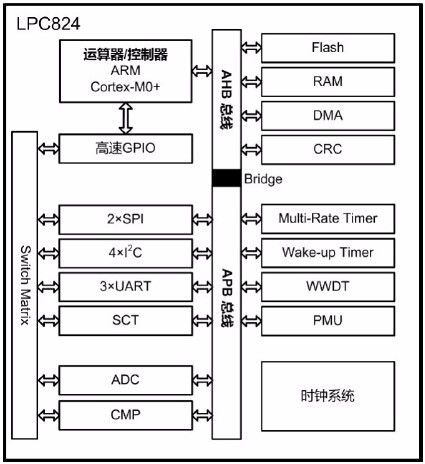
Figure 1.1: LPC824 Functional Block Diagram
The LPC824 series is known for its ultra-low power consumption, with industry-leading performance of 90μA/MHz. It supports four low-power modes, making it ideal for battery-powered applications. In the lowest power mode, it consumes less than 1μA. While these features may seem complex, they are designed to simplify development, much like how a computer’s internal workings don’t interfere with your ability to use it for daily tasks.
The LPC812/824 belongs to the LPC800 series, with the LPC824 offering enhanced peripheral resources compared to the LPC812. Software compatibility is maintained across the series, reducing platform development effort. See Table 1.1 for detailed selection information.
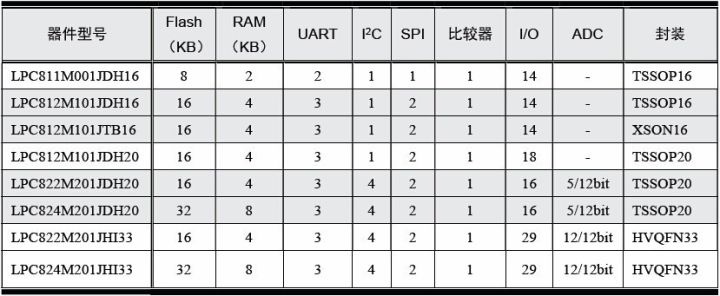
Table 1.1: LPC800 Series MCU Selection Table
The LPC824 series is available in TSSOP20 and HVQFN33 packages. Pinouts are shown in Figure 1.2.
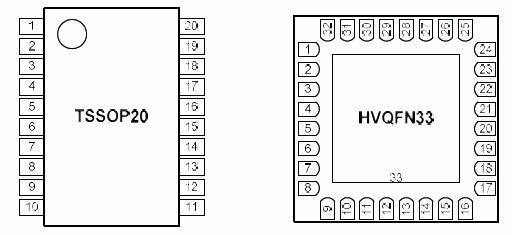
Figure 1.2: Package Schematic
Pin descriptions and main functions are detailed in Table 1.2.
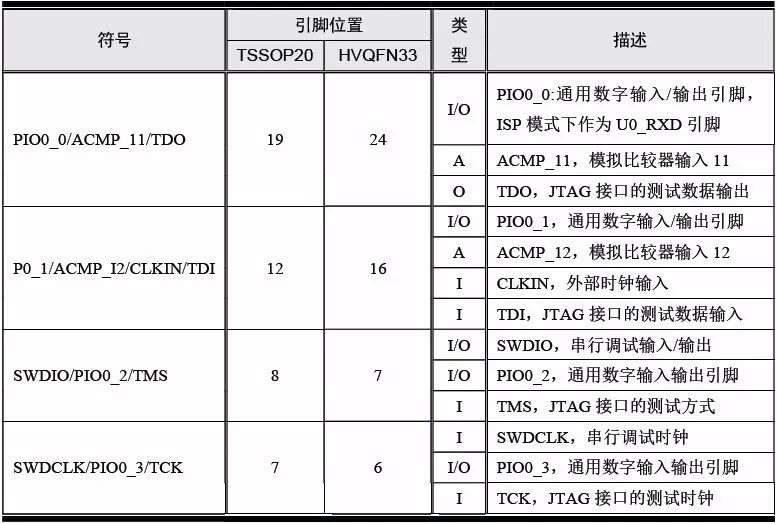
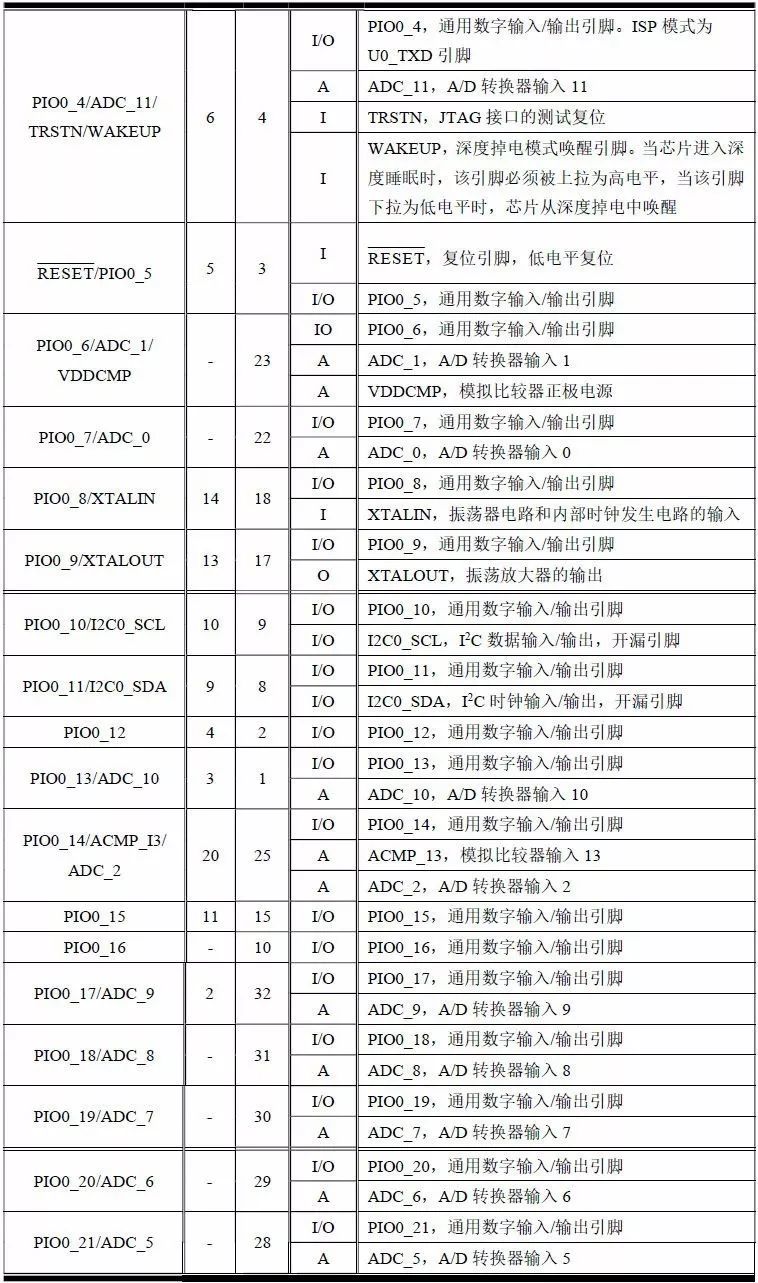
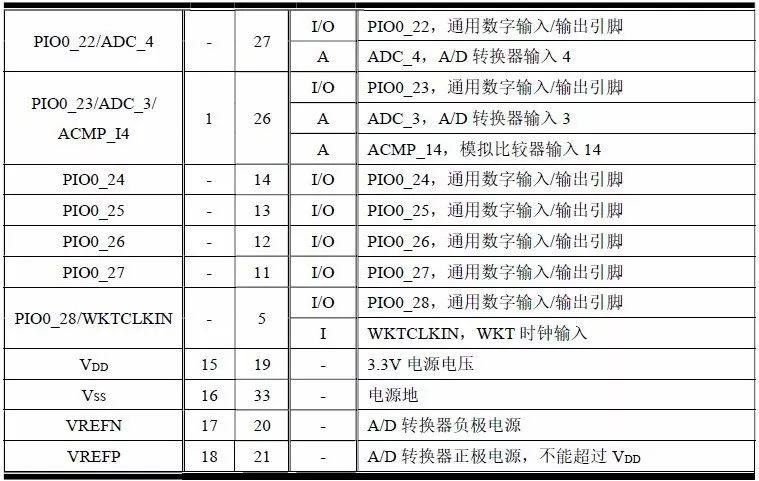
Table 1.2: LPC824 Series Pin Descriptions
1.2 LPC84x Microcontroller
>>> 1.2.1 Features
System:
- ARM Cortex-M0+ processor with runtime frequency up to 30 MHz and single-cycle multiplication;
- Built-in NVIC;
- System tick timer;
- AHB bus matrix;
- Support for SWD and JTAG debugging;
- Micro Tracking Buffer (MTB).
Memory:
- Up to 64KB Flash with 64-byte page write/erase;
- FAIM memory for power-up configuration;
- 16KB SRAM, including two 8KB contiguous blocks, one of which can be used by MTB;
- Support for bit-band operations for atomic bit manipulation.
ROM API Support:
- Bootloader;
- IAP (In-Application Programming);
- ISP (In-System Programming) via USART, SPI, or I²C;
- Integer division API interface.
Digital Peripherals:
- Up to 32 general-purpose I/O pins with configurable pull-up/pull-down, open-drain, and inverter settings;
- 4 pins with 20mA output drive;
- 2 open-drain pins with 20mA sink drive;
- GPIO interrupt with Boolean pattern matching;
- Switch matrix for flexible pin function configuration;
- CRC engine;
- 25-channel DMA with 13 trigger inputs;
- Capacitive touch interface.
Timers:
- SCTimer/PWM with 8 match/capture, 8 events, and 8 states;
- General-purpose timer with 4 matched outputs and 3 input captures;
- MRT for repeatable interrupts at 4 programmable rates;
- WKT with internal or external clock;
- WWDT.
Analog Peripherals:
- 12-bit ADC with 12 channels, up to 1.2 Msamples/s;
- Comparator with 4 input pins and internal/external reference;
- Two 10-bit DACs.
Serial Interfaces:
- 5 USART interfaces with shared fractional baud rate generator;
- 2 SPI controllers;
- 4 I²C interfaces with high-speed mode support up to 1 Mbps.
Clock Generation:
- Free-running oscillator (FRO) with ±1% accuracy at 18MHz, 24MHz, or 30MHz;
- Low-power startup with FAIM memory at 3MHz;
- Crystal oscillator from 1MHz to 25MHz;
- Low-power watchdog oscillator;
- Programmable watchdog oscillator (9.4kHz–2.3MHz);
- PLL for high CPU frequency without high-frequency crystal;
- Clock output with divider for all internal clocks.
Power Control:
- Low power consumption: 90μA/MHz;
- Integrated PMU;
- Supported power modes: Sleep, Deep Sleep, Power Down, Deep Power Down;
- Wake-up from peripherals;
- Self-wake from timer in Deep Power Down mode;
- POR and BOD.
Single power supply: 1.8V to 3.6V, operating temperature: -40°C to +105°C;
Available in LQFP64, LQFP48, HVQFN48, and HVQFN33 packages.
>>> 1.2.2 Overview
The LPC84x family of microcontrollers, as shown in Figure 1.3, offers advanced on-chip peripherals, including a switch matrix, state-configurable timers, multi-rate timers, window watchdog timers, and DMA control. Analog peripherals include a 12-bit high-speed ADC and two 10-bit DACs, along with five UARTs, two SPIs, and four I²C interfaces. A free-running oscillator is integrated for system clock usage.
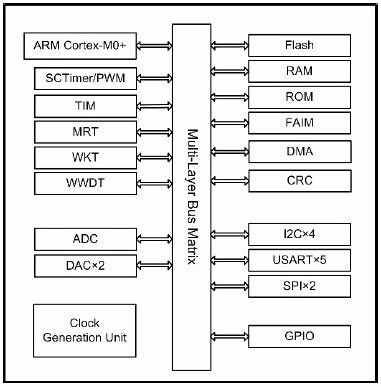
Figure 1.3: LPC84x Functional Block Diagram
The LPC84x series is also known for its ultra-low power consumption, with industry-leading performance of 90μA/MHz. Four low-power modes allow users to optimize power based on application needs, with less than 1μA in the lowest mode. Though the concepts might seem overwhelming at first, they are designed to simplify development, just like how you don’t need to understand a computer’s inner workings to use it effectively.
The LPC84x series is available in four different packages, each suited for specific requirements. See Table 1.3 for more details.
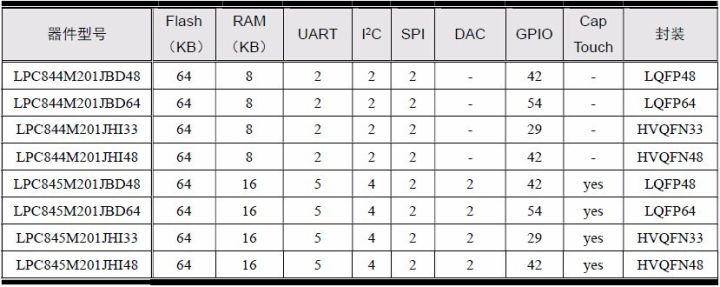
Table 1.3: LPC84x Series MCU Selection Table
The pin descriptions and main functions of the LPC84x series are listed in Table 1.4.
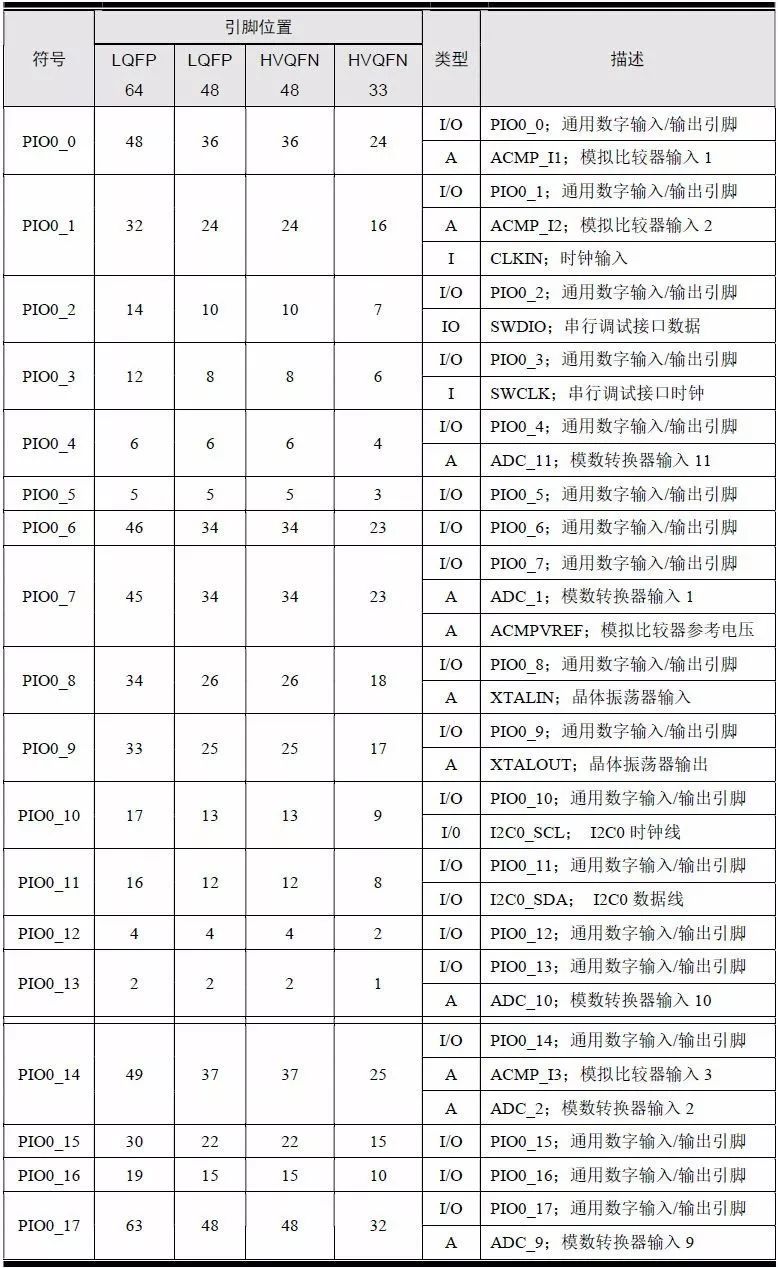
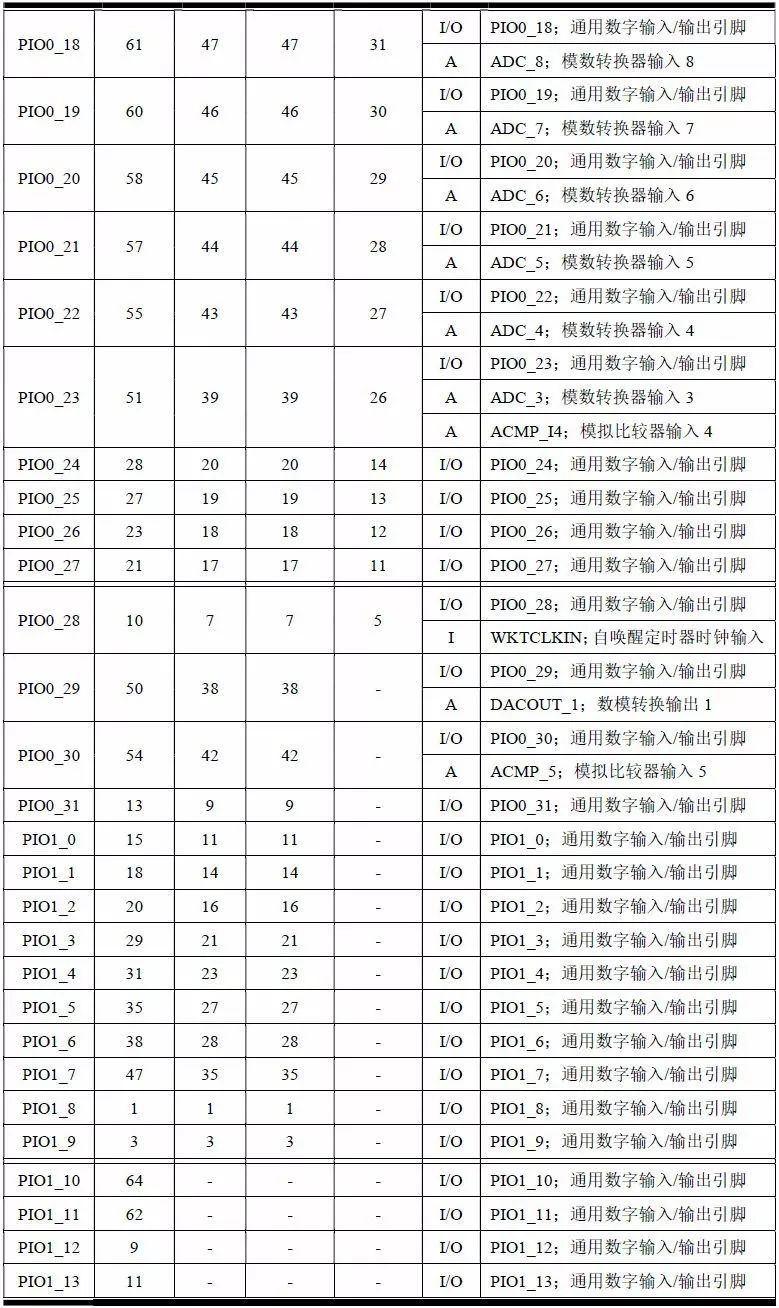
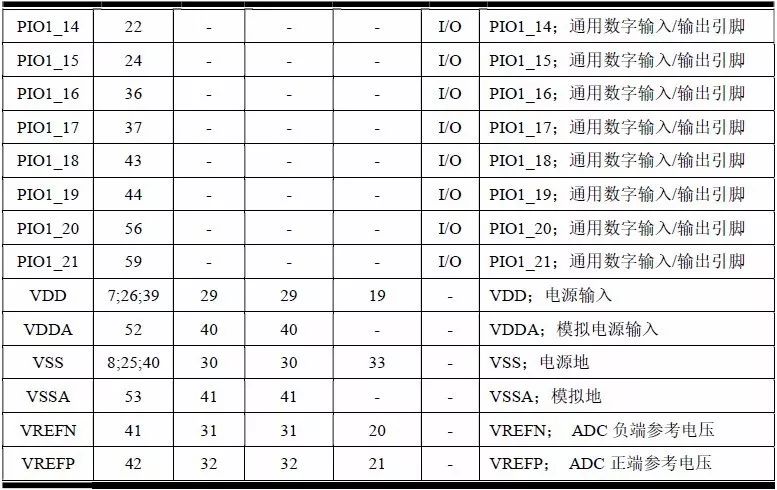
Table 1.4: Pin Description
Support Plate Shaft,Shaft Support Plate,Shaft Supports,Bearing Support Plate
Changzhou Youeryou Trading Co., Ltd. , https://www.farmpartssupplier.com